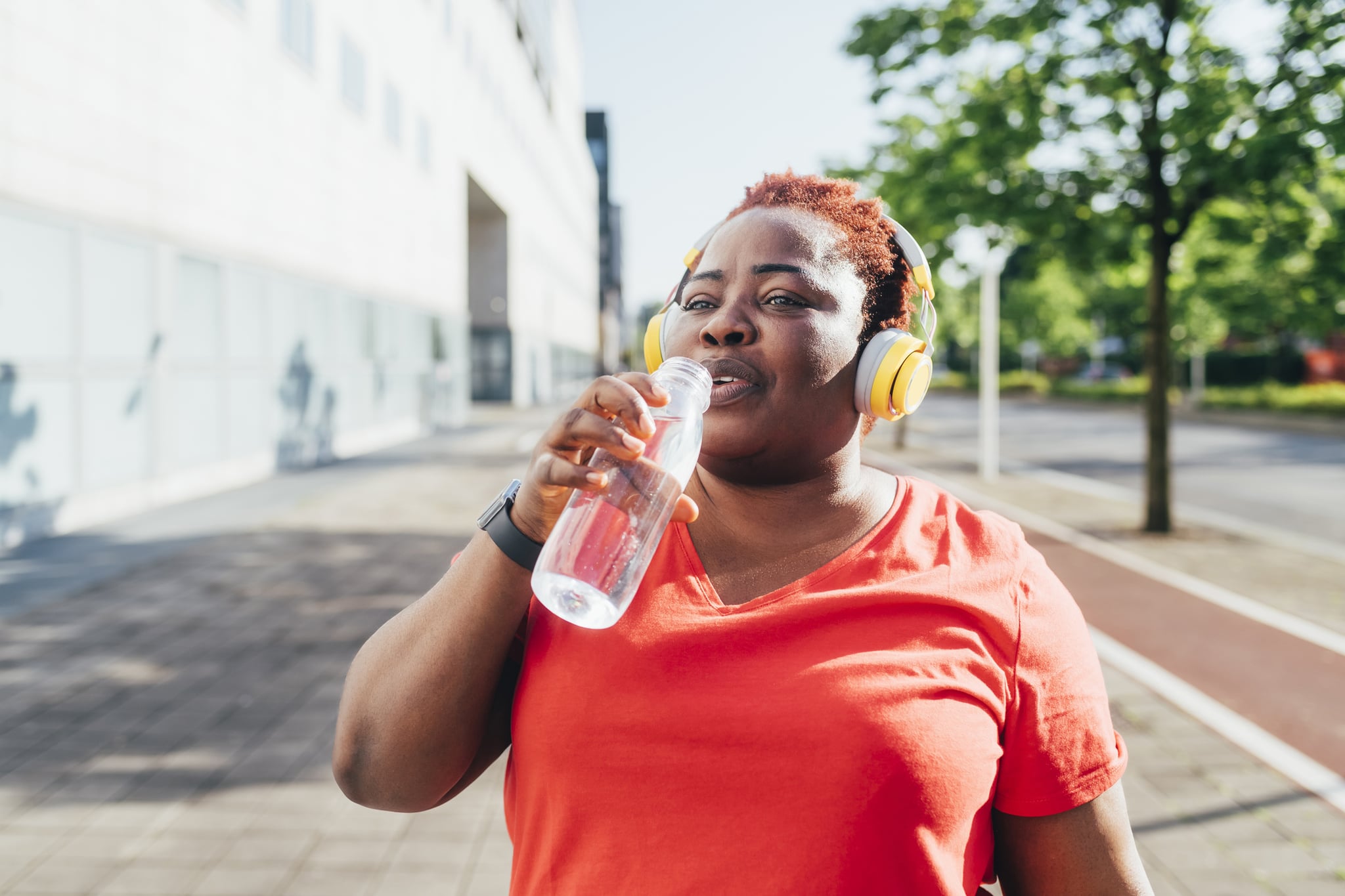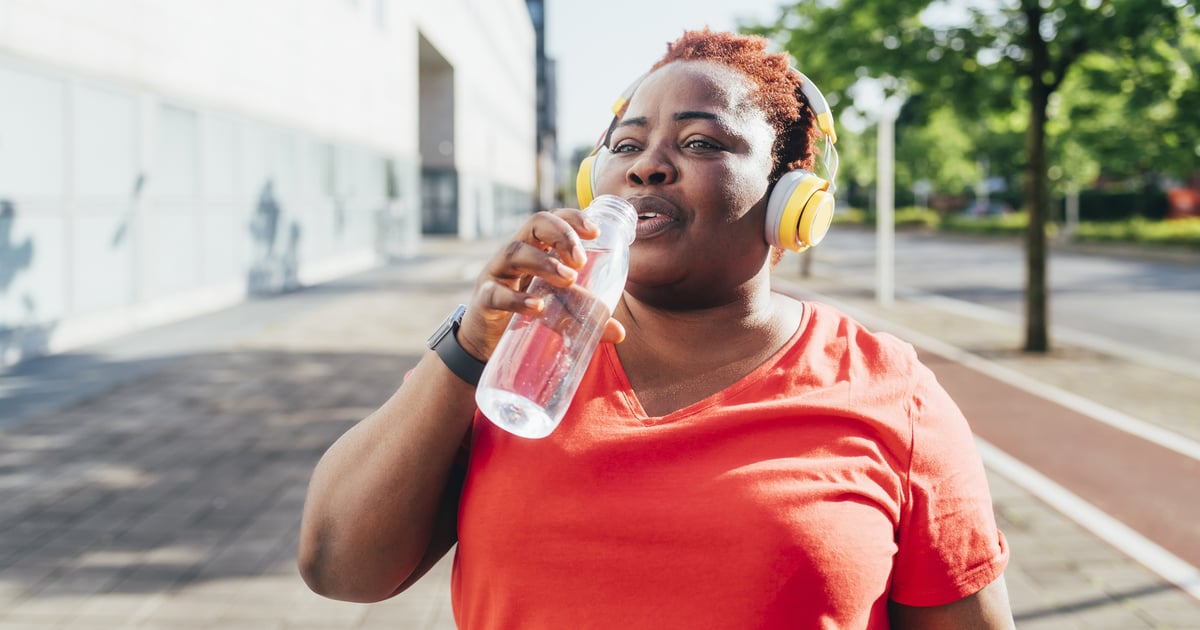
It’s not always easy to drink as much H20 as is recommended on a daily basis, especially when there are so many delicious beverage alternatives — hello, soda — readily available for thirst-quenching purposes. At the end of a marathon or on a hot day in the sun, water may look like, well, a tall drink of water, but on an ordinary Monday spent slogging through a workday, it’s not always the most appealing option.
But adequate H20 consumption is crucial for maintaining not only good physical health but also good mental health. “Drinking enough water helps our bodies function better, and when we drink the right amount, we experience benefits like boosted energy, reduced [food] cravings, and improved focus and productivity,” says certified personal trainer and nutrition specialist Rachel Trotta. “When we don’t get enough hydration, it’s common to feel lethargic, cranky, and even hungry.”
Water also helps regulate body temperature and blood volume, says Dana Hunnes, PhD, RD, senior dietitian at UCLA Medical Center and author of “Recipe For Survival.” “If you don’t have enough blood volume, you don’t get enough oxygen to your vital organs — including intestines and kidneys, and even the brain — which can result in organ dysfunction and even organ failure if severe enough,” she says. Additionally, Dr. Hunnes says water helps lubricate joints and organs, which is important for proper functioning and mobility. It also aids digestion.
And while most of us aren’t getting severely dehydrated on a regular basis, even slightly inadequate H2O levels are going to leave us feeling less than our best. Which is why it may be helpful to get a few tips on how to easily, and perhaps even sneakily, incorporate more water into your daily routine. Below, nutritionists share their favorite hydration hacks featuring H20, the original wellness superstar.
1. Understand How Much You Need to Drink
In order to drink enough water each day, the first step is to understand what “enough” looks like. Most people are familiar with the advice to drink eight glasses of water per day, but Dr. Hunnes says this is a bit of a “myth,” given that there is no one-size-fits-all prescription for H20 consumption. A good general rule to use instead, she says, is to aim for at least one ounce of fluid per kilogram of bodyweight. (To convert your weight in pounds to kilograms, divide the amount in pounds by 2.2.)
This amount should be increased if you’re physically active. “Add an extra bottle or glass with a workout,” says Trotta. “And if you’re doing very intense, sweaty exercise, like endurance running, make sure your workout hydration is supplemented with electrolytes, especially sodium.”
On the flip side, you can probably cut yourself some slack on the water-chugging front if you eat a lot of water-rich fruits and vegetables, says Dr. Hunnes. “That’s why aiming for a ‘rough’ amount to stay well-hydrated is a good idea,” she says.
2. Create a Goal
Once you’ve figured out approximately how much water you should be aiming for each day, make it a goal. (The new year is a perfect time for this!) Having a specific goal to work toward can help to hold you accountable.
At first, it might be helpful to create a chart of some sort where you can follow your progress, just like you did with gold stars in kindergarten. It may sound childish, but each time you achieve a goal, no matter how small, your brain releases dopamine, which serves as positive reinforcement.
3. Set Reminders
Those who spend their days at a desk may have heard the advice to set an alarm notifying you to stand up and move around once every hour. This is a good strategy for remembering to drink water as well. You can set these as you choose, whether it’s a sip every 15 minutes or a full glass every hour — whatever works for you.
4. Drink a Glass of Water as Soon as You Wake Up
While you’re sleeping, your body continues to utilize water in order to keep things functioning, without receiving any replenishment. This can lead to an H20 deficit first thing in the morning. While not absolutely necessary — the most important thing is that you drink water consistently throughout the day — it can be helpful to start the day on the right foot by drinking a glass of water, or hot water with lemon, before or alongside your morning coffee or tea, says Dr. Hunnes.
5. Carry a Water Bottle Throughout the Day
Unless you’ve been living under a rock, your kitchen cabinets are probably overpopulated with water bottles given as free gifts from your workplace, your insurance company, that hotel you visited . . .
Dr. Hunnes suggests putting them to use. “Carrying a bottle of water with you everywhere ensures you’ll have water if and when you want or need it,” she says. “It will also likely prevent you from buying $5 expensive ‘waters’ or other beverages that may not be so good for you.”
Trotta also likes this strategy due to her preference for sipping water throughout the day versus chugging it periodically. “I recommend keeping a bottle with you and having it available during routine parts of your day, so that you can sip on water throughout work calls, in the car while you’re driving, or while you’re writing emails,” she says.
6. Add a Little Flavor
Let’s be honest: a lot of things taste better than water, especially these days, when the beverage aisle is filled with hundreds of options. “Taste is the main obstacle for hydration for many people,” says Trotta. “You can make water more interesting by adding herbal tea or a splash of fruit or citrus juice.” You can add whole fruit, such as berries or citrus slices, too. Dr. Hunnes also suggests ginger as an option for a hot-water add-in, especially for pregnant people who find drinking water difficult.
Just be sure, says Dr. Hunnes, that whatever you’re adding to your water is a healthy choice. “Straight-up juice is filled with sugar — even though it’s natural sugar — and some flavored mix-ins can have a lot of sugar, too, or dyes, which are not recommended,” she says. So if you’re adding juice, it’s best to keep it to a splash.
7. Make It Sparkle
Another easy way to increase your water consumption is to opt for the bubbly stuff. “Sparkling water is an appropriate substitute for plain water, and many people prefer the texture,” says Trotta. “It has more mouthfeel than water and can encourage more sipping.”
With that said, not all of your daily H20 should be carbonated. Because sparkling water is more acidic than still water, it can have negative effects on your teeth. It can also cause excess bloating or gas. And some sparkling waters may have added salt or sugar and include artificial flavoring or sweeteners. Reading nutrition labels can help you make smart choices with respect to sparkling water — and in general, moderation is best.
8. Try Healthy Water Alternatives
Water — still, flavored, or sparkling — is technically your best bet for hydration, but 100 percent of your daily consumption does not have to come from straight H20. “Many beverages count as water intake, even if they’re not pure water — [low- or no-calorie beverages], such as herbal tea, decaf coffee, or decaf lattes, can help with hydration,” says Trotta. According to the Centers For Disease Control and Prevention (CDC), regular coffee counts, too.
The CDC also says you can safely supplement your water consumption with drinks that contain calories and important nutrients if these drinks are enjoyed within recommended calorie limits. Such beverages include low-fat and fat-free milk; unsweetened, fortified milk alternatives; and 100 percent fruit or vegetable juice. (Be wary of fruit-juice “cocktails,” which can be packed with added sugar.)
9. Eat Your H2O
Not all of your daily water intake has to come in a glass. Eating water-rich fruits and vegetables, say both Dr. Hunnes and Trotta, can help with hydration. Examples include: melons, citrus fruits, berries, peaches, cucumbers, celery, lettuce, zucchini, bell peppers, and tomatoes.
“Some meals or snacks can also count toward hydration goals, like soups or smoothies,” says Trotta. Certain dairy products, such as cottage cheese and yogurt, are also hydrating.
10. Check In on H20 Levels During the “Afternoon Slump”
If you only set one water-related timer each day, Trotta suggests making it go off around 3 or 4 p.m. “For some reason, this is a time when many people forget to hydrate, and they start feeling low-energy and hungry,” says Trotta. “Before reaching for a snack, take a little movement break to refill your bottle of water and see if you feel better in about 20 to 30 minutes.”
11. Alternate Your Beverages
One final way to help your hydration levels is to switch up your beverages. Drinking a glass of water after or between each cocktail or caffeinated beverage is a good way to ensure you’re sneaking in some extra H20, which is especially important when the beverage in question has dehydrating properties (such as anything containing alcohol).
Image Source: Getty / Westend61
